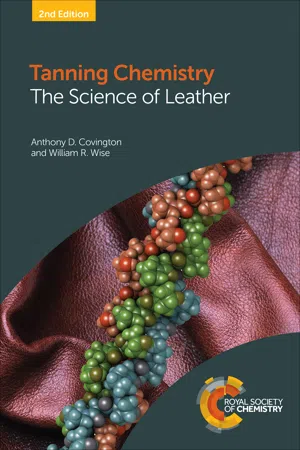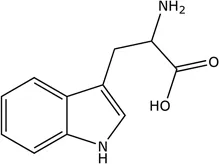
- 660 pages
- English
- ePUB (mobile friendly)
- Available on iOS & Android
About this book
This book offers a state-of-the-art view of leather making, based on the scientific principles underpinning the technology. In particular, it contributes to the understanding of the modern leather industry, allowing practitioners to make judgements about day-to-day problems in the tannery and how change can be applied in a predictable way. Major themes running through the book are the economics and environmental impact of leather making and how these will ensure the sustainability of the industry.
This second edition of Tony Covington's Tanning Chemistry is a revision, update and extension in collaboration with a new co-author, Will Wise. The update reflects the advances made in the past decade, including a discussion of the impact of new information concerning the chemistry of sulfide. The original chapters have been re-organised and new chapters on novel modes of reagent delivery and the principles of finishing are now included. Enzymology is addressed as a separate topic, as are environmental impact and the future of leather.
The book will be useful to all those involved in the supply chain, from farm, through students, chemical suppliers and tanners, to leather goods brands. Leather science is the key to understanding leather technology, to make it work, to make it work better and to keep it ahead of the competition.
Frequently asked questions
- Essential is ideal for learners and professionals who enjoy exploring a wide range of subjects. Access the Essential Library with 800,000+ trusted titles and best-sellers across business, personal growth, and the humanities. Includes unlimited reading time and Standard Read Aloud voice.
- Complete: Perfect for advanced learners and researchers needing full, unrestricted access. Unlock 1.4M+ books across hundreds of subjects, including academic and specialized titles. The Complete Plan also includes advanced features like Premium Read Aloud and Research Assistant.
Please note we cannot support devices running on iOS 13 and Android 7 or earlier. Learn more about using the app.
Information
In order to understand the principles that underpin the conversion of hide or skin to leather, it is necessary to know the fundamental structure of the raw material and how that structure might be modified chemically. The chemistry of collagen defines not only the sequencing of its amino acid constituents but also the physical nature of its structure and how it creates levels of structure or a hierarchy. This depends on the chains creating a triple helix as the basic unit of structure. The chemical properties of collagen are defined by the sidechains on the helices, which may be charged, depending on the pH; in this way, collagen can undergo a wide range of covalent or electrostatic reactions, which are the basis for tanning processes. At the heart of the chemistry of collagen is the relationship with water, which is an integral feature of structure: the supramolecular matrix of water around the triple helices provides the region for chemical modification, leading to tanning technology.
1.1 Introduction


| Name | Abbreviation | Type | Sidechain: R = | Importance in leather making |
| Glycine | Gly | α, neutral | –H | Collagen structure |
| Alanine | Ala | α, neutral | –CH3 | Hydrophobic bonding |
| Valine | Val | α, neutral | –CH(CH3)2 | Hydrophobic bonding |
| Leucine | Leu | α, neutral | –CH2CH(CH3)2 | Hydrophobic bonding |
| Isoleucine | Ileu | α, neutral | CH3CH2CH(CH3) | Hydrophobic bonding |
| Phenylalanine | Phe | α, neutral | –CH2C6H5 | Hydrophobic bonding |
| Serine | Ser | α, neutral | –CH2OH | Unhairing |
| Cysteine | CySH | α, neutral, S containing | –CH2SH | Unhairing |
| Cystine | CyS–SCy | α, neutral, S containing | –CH2SSCH2– | Unhairing |
| Aspartic acid | Asp | α, acidic | –CH2CO2H | Isoelectric point (IEP),a mineral tanning |
| Asparagine | Asn | α, neutral | –CH2CONH2 | IEP |
| Glutamic acid | Glu | α, acidic | –(CH2)2CO2H | IEP, mineral tanning |
| Glutamine | Gln | α, neutral | –(CH2)2CONH2 | IEP |
| Arginine | Arg | α, basic | –(CH2)3NHC(NH)NH2 | IEP |
| Lysine | Lys | α, basic | –(CH2)4NH2 | IEP, aldehydic tanning, dyeing, lubrication |
| Histidine | His | α, basic |  | Aldehydic tanning, dyeing, lubrication |
| Proline | Pro | β, neutral | See Figure 1.1 | Collagen structure |
| Hydroxyproline | Hypro | β, neutral | See Figure 1.1 | Collagen structure, hydrogen bonding |

Table of contents
- Cover
- Halftitle
- Title
- Copyright
- Preface to the First Edition
- Preface to the Second Edition
- Dedication
- Acknowledgements
- Contents
- Introduction
- Introduction to the Second Edition
- Glossary of Termss
- 1 Collagen and Skin Structure
- 2 Skin and Its Components
- 3 Curing and Preservation of Hides and Skins
- 4 Soaking
- 5 Unhairing
- 6 Liming
- 7 Deliming
- 8 Bating
- 9 Pickling
- 10 Tanning
- 11 Mineral Tanning: Chromium(iii)
- 12 Mineral Tanning
- 13 Vegetable Tanning
- 14 Other Tannages
- 15 Post-tanning
- 16 Dyeing
- 17 Fatliquoring
- 18 Enzymology
- 19 Reagent Delivery
- 20 Drying
- 21 Finishing
- 22 Environmental Impact
- 23 Theory of Tanning: the Concept of Link–Lock
- 24 The Future of Tanning Chemistry
- 25 The Future for Leather